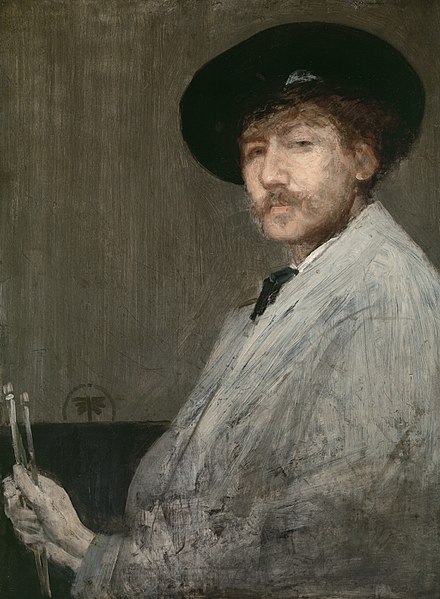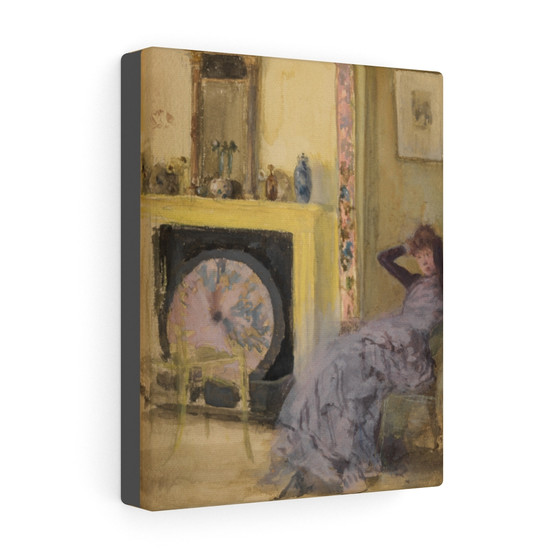James Abbott McNeill Whistler
kjs on 27th May 2022
His Early Life
James Abbott McNeill Whistler, commonly known as James Whistler (1834-1903) was an Americal born artist noted for his paintings of nocturnal London, striking full-length portraits and brilliant etchings and lithographs. Whistler was born of Scottish-Irish ancestry. His father, George Washington Whistler, a West Point graduate and a brilliant civil engineer, was one of his parents’ five children, of whom only two, James and William, survived. Beginning in 1842, the family spent six years in St. Petersburg, Russia, where George served Tsar Nicholas I as the chief engineer of a rail line to Moscow.
His Early Paintings in Paris and Success
Whistler went back to the US in 1849 where he attended the United States Military Academy at West Point. However, he soon abandoned the army for art. He arrived in Paris in 1855 as he was fascinated by the city’s fame as a hub of artists and painters. He was soon responding to the realism associated with the painters like Gustave Courbet, Henri Fantin-Latour and Francois Bonvin. He painted his early works ‘Self-portrait’ and ‘Twelve Etchings from Nature’ which are also called ‘The French Set’. Whistler won considerable success in Paris when his painting ‘Symphony in White No.1: The White Girl’ was shown at the Salon des Refuses in 1863.
Influence of Japanese Style of Painting
Whistler took delight in the Japanese arts and some of his famous paintings that had the influence of the Japanese style were ‘The princes from the Land of Porcelain’, (1863-65), ‘Caprice in Purple and Gold: The Golden Screen’ (1864), ‘Symphony in grey and Green: The Ocean (1866), ‘Nocturne: Blue and Gold – Old Battersea Bridge’, etc. During the 1860s and 1870s, Whistler began to give musical titles to his paintings such as Symphony and harmony. From 1870 onwards, Whistler was concentrating on portrait painting, creating a number of masterpieces, including ‘Arrangement in Grey and Black No.1 (1871), Harmoney in Grey and Green: Miss Cicely Alexander (1872 -74), ‘Arrangement in Grey and Black, No.2’ (1872-73), ‘Symphony in Flesh Colour and Pink: Portrait of Mrs Frances Leyland’ (1871-74), etc. Experts say that these paintings underline his attraction to the work of the 17th-century Spanish painter Diego Velaquez.
Libel Suit Against John Ruskin
Whistler painted the famous ‘Harmoney in Blue and Gold: The Peacock Room’ (1876-77) for No.49, Prince Gate, London, the house of F.R. Layland, a Liverpool shipping magnate. However, the decoration failed to please his patron, who felt that Whistler had exceeded his commission. In 1877, Whistler brought a libel suit against the celebrated writer, John Ruskin, for the latter attack on his painting ‘Nocturne in Black and Gold: The Falling Rocket’. Though he won the case, he received only meagre sum as damages. The substantial costs incurred by him in the case made him to declare bankruptcy in 1879. As a result, he was forced to move out of his charming home, the White House in Chelsea.
The Final Days of His Life
Whistler had to face problems in his later years as it was felt that he was out of step with the modern movements in the painting arena. He made many etchings at a time when colour lithographs were becoming popular. However, his black and white lithographs are delightful. There were only three or four of his lithographs were in colour. In 1888, he married Beatrice Godwin and spent much of his time in Paris. When his wife died in 1896, Whistler became deeply upset and his final years were spent in grief. With his productive period having passed, he ran an art school in Paris. Whistler believed that ‘while music is the poetry of sound, the painting is the poetry of sight and the subject matter has nothing to do with harmony of sound or of colour‘ James McNeill Whistler died on 17th June 1903, aged 69, in London, England.
Whistler’s Famous Painting ‘Whistler’s Mother‘
The subject of the painting is Whistler’s mother Anna McNeill Whistler. In 1891, the painting became the first American artwork ever bought y the French state. It remains the most important American work residing outside the United State. The painting represents the peak of Whistler’s radical method of modulating tones of single colours. The painting has also been often described as an Americal icon and a Victorian Mona Lisa.
Whistler’s famous paintings include ‘Arrangement in Grey and Black no.1(1871) also called ‘Portrait of the Artist’s Mother or Whistler’s Mother’. Anna McNeill Whistler, the painter’s mother, lived with her son in London from 1864 to 1875. Anna was aware of her son’s flamboyant Bohemian lifestyle, however, she tolerated it. In the portrait painting, she sits in profile with an air of infinite patience, gazing at nothing in particular. The painting struck a chord with the audiences during the Great Depression as a symbol of mothers stoically bearing hardships. Anna was 67 years old when Whistler made this painting.








